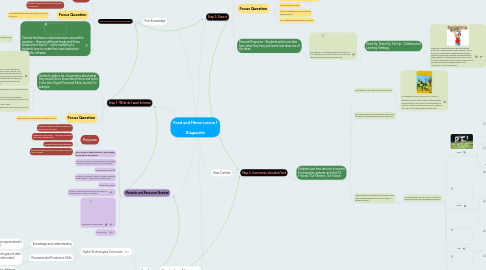
1. Prior Knowledge
1.1. Step 2: Brainstorm Foods and Fibres
1.1.1. Purpose
1.1.1.1. Diagnostic information - What do the students know.
1.1.1.2. Engage students with the topic
1.1.1.3. Engage students with the technologies - Mindmeister
1.1.2. Focus Question
1.1.2.1. How are different foods and fibres produced on farms?
1.1.3. Teacher facilitates a class brainstorm around the question - How are different foods and fibres produced on farms? – while modelling to students how to create their own brainstorm using the software.
1.1.3.1. Example of answers you could expect from students.
1.1.3.1.1. Different types of vegetables are planted in soil and grown.
1.1.3.1.2. Sheep, cattle and pigs are kept and grown for meat.
2. Step 1 - What do I want to know
2.1. Students make a list of questions about what they would like to know about farms and enter it into their Digital Food and Fibre Journal. For example;
2.1.1. OneNote Digital Journal - Each student has their own digital Food and Fibre Journal. The Journal takes the students through the unit of work collecting and collating the students work samples, as well as providing opportunities for students to store and use different types of data in different ways.
2.1.2. Example of questions you could expect from students; • How do farms collect all the wheat? •How do farms stop foxes from eating all the sheep? •How do you farm fish? •What can farms do to stop the animals from getting sick?
2.2. Focus Question
2.2.1. What would you like to find out about farms?
2.3. Purpose
2.3.1. Determine what students would like to know about the topic.
2.3.2. Diagnostic information - Infer what students think they already know.
2.3.3. Engage students with the topic
2.3.4. Engage students with their OneNote Food and Fibre Journals.
3. Curriculum Alignment
3.1. Year 3
3.1.1. Digital Technologies Curriculum
3.1.1.1. Knowledge and understanding
3.1.1.1.1. Different types of data can be represented in different ways (ACTDIK008)
3.1.1.2. Processes and Production Skills
3.1.1.2.1. Collect and present different types of data using simple software to create useful information (ACTDIP009)
3.1.2. Design and Technologies Curriculum
3.1.2.1. Knowledge and Understanding
3.1.2.1.1. Types of food and fibre produced in different environments, cultures or time periods, including the equipment used to produce or prepare them (ACTDEK012)
3.1.3. English
3.1.3.1. Literacy
3.1.3.1.1. Interacting with Others
4. Materials and Resources Needed
4.1. Smart board or digital display of some variety connected to the internet.
4.2. Microsoft OneNote Application and a digital Foods and Fibre Journal for each student.
4.3. Mindmeister accounts
4.4. A device for each student to access required technologies - iPad, tablets, laptop's etc.
4.5. Paper and pencils.
4.6. Access to Envirostories website and their 16 e-books ‘Our Farmers, Our Future.’
4.7. Technology Safety Rules
4.8. Group Rules
5. New Content
5.1. Step 4: Summarise allocated Text
5.1.1. Students use their devices to access Envirostories website and their 16 e-books ‘Our Farmers, Our Future.’
5.1.1.1. Each group is allocated a different e-book
5.1.1.1.1. For Example 'WHAT WE HAVE ON FARMS' What we have on farms looks at the different animals that live on a farms and what they are used for. This includes for work, food, clothing and other useful items we use every day.
5.1.1.2. Each group reads their selected e-book aloud as a group. Students then discuss the book.
5.1.1.3. Groups then use one device to create a mind map using Mindmeister. The Mind Map is explain the text.
5.1.1.3.1. For example WHAT WE HAVE ON FARMS mind map might look something like this...
6. Step 3: Draw it
6.1. Purpose
6.1.1. Diagnostic information - What do the students know.
6.1.2. Engage students with the topic
6.1.3. Engage students with each other
6.1.4. Engage students with the technologies
6.2. Focus Question
6.2.1. How are different foods and fibres produced on farms?
6.2.2. Which idea will I draw?
6.2.3. Does my drawing communicate the idea/concept?
6.2.4. Can I explain my drawing to my peers?
6.3. Personal Response - Students select one idea from what they have just learnt and draw one of the ideas.
6.3.1. For example, a students might draw a seed in soil and then as a seedling, then as a plant and then with the fruit and then the fruit.
6.3.1.1. Hand Up, Stand Up, Pair Up - Collaborative Learning Strategy.
6.3.1.1.1. Students circulate the room by putting their hand up to indicate they need a partner, once a partner is located the students high five then students share their drawing and idea with the other student. Students then thank each other for their contribution and continue to process to find and share with another partner until instructed to finish by teacher.
